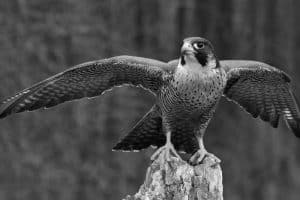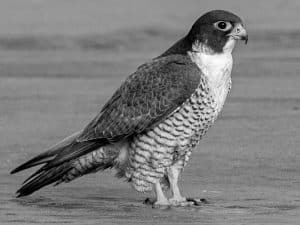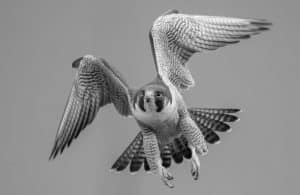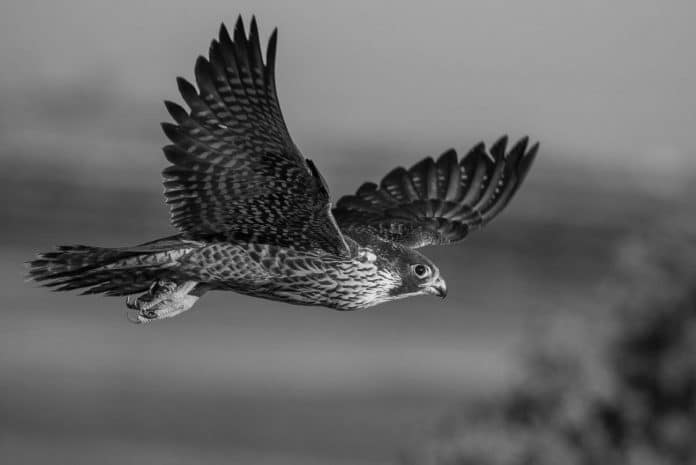Introduction to the Majestic Falcons in Tanzania
Tanzania, with its diverse ecosystems and abundant wildlife, is a paradise for nature enthusiasts and bird lovers. Among the many fascinating bird species found in this East African country, falcons stand out for their grace, beauty, and aerial prowess. Falcons are known for their incredible speed and agility, making them formidable hunters in the sky. In this article, we will delve into the world of falcons in Tanzania, discovering their different species, habitat, behavior, migration patterns, and the conservation efforts in place to protect these majestic creatures.
Falcon Species Found in Tanzania

Tanzania boasts a rich variety of falcon species, each with its unique characteristics and adaptations. One of the most commonly spotted falcons in Tanzania is the Peregrine Falcon (Falco peregrinus), renowned for its exceptional speed and ability to reach incredible heights during its hunting dives. The Lanner Falcon (Falco biarmicus) is another prominent species, known for its striking appearance and powerful flight. Other falcon species found in Tanzania include the African Hobby (Falco cuvierii), Sooty Falcon (Falco concolor), and Amur Falcon (Falco amurensis). Each species adds to the vibrant tapestry of Tanzania’s avian diversity, making it a dream destination for bird enthusiasts.
Peregrine Falcon
The Peregrine Falcon, also known as the “cheetah of the skies,” is a true marvel of nature. With speeds that can exceed 240 miles per hour during its hunting stoops, it is the fastest bird in the world. The Peregrine Falcon is easily recognizable by its sleek body, pointed wings, and distinctive dark head. These birds are often found near cliffs and mountains, where they build their nests and use the vantage point to spot their prey. In Tanzania, you can encounter Peregrine Falcons in the highlands and mountainous regions, such as the Ngorongoro Conservation Area and Mount Kilimanjaro.
Lanner Falcon
The Lanner Falcon is a medium-sized falcon with a robust build and a fierce gaze. Its plumage varies in color, ranging from pale to dark, with distinctive black “mustache” markings on its face. Lanner Falcons are adept hunters, preying on small to medium-sized birds and rodents. They are frequently observed in open habitats, including grasslands, savannas, and agricultural areas. In Tanzania, you can spot Lanner Falcons in national parks like Serengeti, Tarangire, and Ruaha.
African Hobby
The African Hobby is a small falcon with a slender body and long, pointed wings. Its plumage is predominantly brown, with streaks of white and black. African Hobbies are known for their aerial acrobatics, often seen twisting and turning mid-flight as they chase their prey. These falcons primarily feed on insects and small birds. When visiting Tanzania, keep an eye out for African Hobbies in woodland areas, such as Lake Manyara National Park and Arusha National Park.
Habitat and Behavior of Falcons in Tanzania
Falcons in Tanzania inhabit a range of diverse habitats, showcasing their adaptability to different environments. From the towering mountains to the arid plains, these remarkable birds have found their niche in various ecosystems. Falcons typically prefer open spaces where they can soar through the skies in search of prey. Their keen eyesight allows them to spot potential meals from great distances, enabling them to execute precise hunting maneuvers.
In addition to their hunting prowess, falcons also engage in fascinating social behavior. They are known to be monogamous creatures, forming pair bonds that can last for several breeding seasons. Falcons build their nests in elevated locations, such as cliffs, trees, or man-made structures. These nests provide a safe haven for their eggs and young chicks. Falcons demonstrate exceptional parental care, sharing the responsibilities of incubating the eggs and providing food for their offspring.
Migration Patterns of Falcons in Tanzania
Migration is an integral part of the lives of many bird species, including falcons. Tanzania serves as a crucial stopover and wintering ground for migratory falcons, as they traverse vast distances during their annual journeys. These migratory patterns are driven by the availability of food and favorable climatic conditions. Falcons from Europe, Asia, and other parts of Africa make their way to Tanzania during the winter months, seeking warmer temperatures and abundant prey.
The Amur Falcon, in particular, embarks on an extraordinary migration, traveling from its breeding grounds in northeastern Asia to southern Africa. This impressive journey covers thousands of miles and involves crossing deserts, mountains, and large bodies of water. Tanzania’s favorable climate, rich food sources, and protected habitats make it an ideal destination for these migratory falcons. Witnessing the arrival of these magnificent birds is a spectacle that leaves visitors in awe of the wonders of nature.
Conservation Efforts for Falcons in Tanzania

The conservation of falcons and their habitats is of paramount importance to ensure their survival and the preservation of Tanzania’s biodiversity. Several organizations and initiatives are actively working towards protecting falcons and raising awareness about their conservation needs. These efforts include research projects to monitor population trends, habitat restoration, and the establishment of protected areas.
One such initiative is the Tanzania Falcon Conservation Project, which focuses on studying and conserving falcons in the country. Through their research, the project aims to gather data on falcon populations, understand their ecological requirements, and identify potential threats. This valuable information helps inform conservation strategies and ensures that appropriate measures are taken to safeguard these magnificent birds.
To support these conservation efforts, it is crucial for visitors to adhere to responsible tourism practices. This includes respecting the natural habitats of falcons, refraining from disturbing nesting sites, and following designated trails when observing these beautiful creatures. By being mindful of our impact on the environment, we can play a part in preserving Tanzania’s falcon populations for future generations.
Best Places to Spot Falcons in Tanzania
Tanzania offers numerous opportunities to observe and appreciate the beauty of falcons in their natural habitats. Whether you are an experienced birdwatcher or a curious traveler, these locations provide unforgettable experiences for falcon enthusiasts.
Ngorongoro Conservation Area
The Ngorongoro Conservation Area is a UNESCO World Heritage Site renowned for its breathtaking landscapes and diverse wildlife. This unique area is home to a variety of falcon species, including the iconic Peregrine Falcon. The steep cliffs and open grasslands provide ideal hunting grounds for these magnificent birds. Visitors can witness the impressive aerial displays of falcons as they swoop down at incredible speeds during their hunting dives.
Serengeti National Park
As one of Africa’s most famous national parks, the Serengeti is a must-visit destination for wildlife enthusiasts. This vast savanna ecosystem is not only home to the iconic Great Migration but also hosts a thriving population of falcons. The Lanner Falcon, with its powerful flight and striking appearance, can often be spotted perched on acacia trees or scanning the plains for prey. Keep your binoculars handy as you explore the Serengeti, and you may be rewarded with captivating falcon sightings.
Tarangire National Park
Tarangire National Park is renowned for its large elephant herds and diverse birdlife. Falcons find sanctuary in this beautiful park, taking advantage of the abundant prey and varied habitats. The African Hobby, with its agile flight and insect-feeding habits, frequents the woodlands and open plains of Tarangire. Explore the park’s scenic landscapes and keep a lookout for these small falcons darting through the air in pursuit of their insect meals.
Tips for an Unforgettable Falcon-Watching Experience in Tanzania

To make the most of your falcon-watching experience in Tanzania, here are some helpful tips to enhance your adventure:
- Choose the right time: Falcons are most active during the early morning and late afternoon, so plan your outings accordingly to maximize your chances of spotting them in action.
- Bring binoculars and a camera: Falcons are often perched high up or soaring in the distance, so having binoculars will allow you to observe them up close. Capture the beauty of these birds with a camera to cherish the memories.
- Dress appropriately: Wear comfortable clothing and sturdy shoes suitable for outdoor exploration. Protect yourself from the sun with a hat, sunglasses, and sunscreen.
- Join a guided tour: Engaging the services of an experienced guide will greatly enhance your falcon-watching experience. Guides have extensive knowledge of the local birdlife and can lead you to the best spots for falcon sightings.
- Respect nature: Remember to maintain a safe distance from the falcons and their habitats. Avoid making loud noises or sudden movements that may disturb these birds or other wildlife in the vicinity.
With these tips in mind, you are well-prepared to embark on an unforgettable falcon-watching adventure in Tanzania.
Other Wildlife Encounters in Tanzania
While falcons are undoubtedly a highlight of Tanzania’s wildlife, the country offers a myriad of other incredible animal encounters. From the iconic lions of the Serengeti to the majestic elephants of Tarangire, Tanzania is a treasure trove of biodiversity. Witness the Great Migration as millions of wildebeest and zebras traverse the plains, or go on a thrilling safari to spot elusive predators like leopards and cheetahs. With its diverse ecosystems and protected areas, Tanzania guarantees a truly immersive wildlife experience.
Recommended Tours and Guides for Falcon-Watching in Tanzania
To ensure a seamless and enriching falcon-watching experience in Tanzania, consider joining a guided tour led by experts in avian conservation and local wildlife knowledge. These tours provide valuable insights into the behavior, ecology, and conservation efforts surrounding falcons. They also offer the opportunity to explore other remarkable destinations and witness Tanzania’s incredible wildlife diversity. Here are some recommended tours and guides for your consideration:
- Tanzania Falcon Watch: This specialized tour company focuses on birdwatching and falcon conservation in Tanzania. Their knowledgeable guides will take you to prime falcon-watching locations and share their expertise on these magnificent birds.
- Birding Tanzania: With a deep passion for birds and their conservation, Birding Tanzania offers customized birdwatching tours throughout the country. Their experienced guides will ensure an immersive and educational falcon-watching experience.
Conclusion: Embracing the Beauty and Wonder of Falcons in Tanzania
Tanzania is a land of remarkable natural beauty and abundant wildlife, where the majestic falcons soar through the skies in all their glory. From the impressive speed of the Peregrine Falcon to the striking appearance of the Lanner Falcon, these birds captivate our imagination and remind us of the wonders of the natural world. By exploring Tanzania’s diverse habitats and supporting conservation efforts, we can ensure the continued existence of these magnificent creatures for generations to come. So, pack your binoculars, embark on a falcon-watching adventure, and embrace the beauty and wonder of falcons in Tanzania.

































